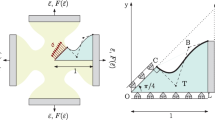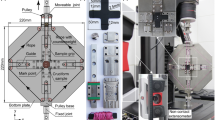Abstract
It is in general challenging to characterize planar mechanical properties of extremely soft tissues such as cell-seeded collagen gels. One of the difficulties is related to premature failure of specimens. This issue may be resolved by employing fillets on stress-concentrated spots of the specimen. The existence of fillets, however, complicates the estimation of stress at the center of the specimen where stiffness data are collected. In this study, cruciform rubber specimens with two types of fillets (general vs. cut-in fillets) at the intersections of perpendicular arms were prepared and subjected to planar biaxial mechanical testing, aiming at investigating how the fillets affect the estimation of mechanical properties of cruciform specimens. Digital image correlation was used to analyze full-field deformation in the central region of the specimens. Finite element analysis with a Neo-Hookean model was performed to simulate the full-field deformation under the same experimental boundary conditions. The strain distribution for each specimen geometry obtained by finite element analysis was found to be in good agreement with that analyzed by digital image correlation, validating the finite element models. Finite element simulation showed that the greatest value of the maximum principal strain decreased with increasing the fillet radius regardless of the fillet type. Increasing the fillet radius, in general, also reduced the strain field uniformity in the central region. Compared with general fillets, however, the use of cut-in fillets provided greater strain field uniformity given the same fillet radius. Finite element analysis was also used to estimate effective transverse length required to convert tensile force at the boundary to local stress at the center. It was found that the effective transverse length for each specimen geometry remained relatively constant if the specimen was not excessively deformed (i.e., global equibiaxial stretch ≤ 1.2). We suggest using cut-in fillets at the intersections of perpendicular arms when preparing cruciform specimens for testing extremely soft tissues.















Similar content being viewed by others
References
Ehrlich HP (1988) Wound closure - evidence of cooperation between fibroblasts and collagen matrix. Eye 2:149–157
Bell E, Ivarsson B, Merrill C (1979) Production of a tissue-like structure by contraction of collagen lattices by human-fibroblasts of different proliferative potential invitro. Proc Natl Acad Sci U S A 76(3):1274–1278
Harris AK, Stopak D, Wild P (1981) Fibroblast traction as a mechanism for collagen morphogenesis. Nature 290(5803):249–251
Feng Z, Tateishi Y, Nomura Y, Kitajima T, Nakamura T (2006) Construction of fibroblast-collagen gels with orientated fibrils induced by static or dynamic stress: toward the fabrication of small tendon grafts. J Artif Organs 9(4):220–225
Grenier G, Remy-Zolghadri M, Larouche D, Gauvin R, Baker K, Bergeron F, Dupuis D, Langelier E, Rancourt D, Auger FA, Germain L (2005) Tissue reorganization in response to mechanical load increases functionality. Tissue Eng 11(1–2):90–100
Shi YL, Vesely I (2003) Fabrication of mitral valve chordae by directed collagen gel shrinkage. Tissue Eng 9(6):1233–1242
Thomopoulos S, Fomovsky GM, Holmes JW (2005) The development of structural and mechanical anisotropy in fibroblast populated collagen gels. J Biomech Eng-Transact Asme 127(5):742–750
Jhun CS, Evans MC, Barocas VH, Tranquillo RT (2009) Planar biaxial mechanical behavior of bioartificial tissues possessing prescribed fiber alignment. J Biomech Eng-Transact Asme 131 (8)
Lanir Y, Fung YC (1974) 2-Dimensional mechanical-properties of rabbit skin.1. Experimental system. J Biomech 7(1):29–34
Bell BJ, Nauman E, Voytik-Harbin SL (2012) Multiscale strain analysis of tissue equivalents using a custom-designed biaxial testing device. Biophys J 102(6):1303–1312
Sun W, Sacks MS, Scott MJ (2005) Effects of boundary conditions on the estimation of the planar biaxial mechanical properties of soft tissues. J Biomech Eng 127(4):709–715
Waldman SD, Lee JM (2005) Effect of sample geometry on the apparent biaxial mechanical behaviour of planar connective tissues. Biomaterials 26(35):7504–7513
Hu JJ, Liu YC, Chen GW, Wang MX, Lee PY (2013) Development of fibroblast-seeded collagen gels under planar biaxial mechanical constraints: a biomechanical study. Biomech Model Mechanobiol. 12(5):849-868. doi:10.1007/s10237-012-0448-x
Mcculloch AD, Smaill BH, Hunter PJ (1987) Left-ventricular epicardial deformation in isolated arrested dog heart. Am J Physiol Heart Circ Physiol 252(1):H233–H241
Eilaghi A, Flanagan JG, Brodland GW, Ethier CR (2009) Strain uniformity in biaxial specimens is highly sensitive to attachment details. J Biomech Eng 131(9):091003. doi:10.1115/1.3148467
Knezevic V, Sim AJ, Borg TK, Holmes JW (2002) Isotonic biaxial loading of fibroblast-populated collagen gels: a versatile, low-cost system for the study of mechanobiology. Biomech Model Mechanobiol 1(1):59–67
Smits A, Van Hemelrijck D, Philippidis TP, Cardon A (2006) Design of a cruciform specimen for biaxial testing of fibre reinforced composite laminates. Compos Sci Technol 66(7–8):964–975. doi:10.1016/j.compscitech.2005.08.011
Welsh JS, Adams DF (2002) An experimental investigation of the biaxial strength of IM6/3501-6 carbon/epoxy cross-ply laminates using cruciform specimens. Compos Part A-Appl S 33(6):829–839. doi:10.1016/S1359-835x(01)00142-7
Makris A, Vandenbergh T, Ramault C, Van Hemelrijck D, Lamkanfi E, Van Paepegem W (2010) Shape optimisation of a biaxially loaded cruciform specimen. Polym Test 29(2):216–223. doi:10.1016/j.polymertesting.2009.11.004
Holzapfel GA, Ogden RW (2009) On planar biaxial tests for anisotropic nonlinearly elastic solids. A continuum mechanical framework. Math Mech Solids 14(5):474–489
Pan B, Qian KM, Xie HM, Asundi A (2009) Two-dimensional digital image correlation for in-plane displacement and strain measurement: a review. Meas Sci Technol 20 (6)
Beda T (2005) Optimizing the Ogden strain energy expression of rubber materials. J Eng Mater-T Asme 127(3):351–353
Ogden RW, Saccomandi G, Sgura I (2004) Fitting hyperelastic models to experimental data. Comput Mech 34(6):484–502
Lecompte D, Smits A, Sol H, Vantomme J, Van Hemelrijck D (2007) Mixed numerical-experimental technique for orthotropic parameter identification using blaxial tensile tests on cruciform specimens. Int J Solids Struct 44(5):1643–1656
Huang LX, Sun XS, Liu YH, Cen ZZ (2004) Parameter identification for two-dimensional orthotropic material bodies by the boundary element method. Eng Anal Bound Elem 28(2):109–121
Grediac M, Toussaint E, Pierron F (2002) Special virtual fields for the direct determination of material parameters with the virtual fields method. 2 - Application to in-plane properties. Int J Solids Struct 39(10):2707–2730
Humphrey JD, Vawter DL, Vito RP (1987) Quantification of strains in biaxially tested soft-tissues. J Biomech 20(1):59–65
Hu JJ, Fossum TW, Miller MW, Xu H, Liu JC, Humphrey JD (2007) Biomechanics of the porcine basilar artery in hypertension. Ann Biomed Eng 35(1):19–29
Acknowledgments
The authors would like to thank Dr. Chih-Han Chang for his advice on finite element simulation. Technical assistance provided by Mei-Xuan Wang was gratefully acknowledged. This research was supported by a grant from the National Science Council in Taiwan (NSC-97-2218-E-006-289-MY2).
Author information
Authors and Affiliations
Corresponding author
Electronic supplementary material
Below is the link to the electronic supplementary material.
Supplemental Figure 1
Simulated E11 along the diagonal line (A) and the horizontal centerline (B) of the ROI of the R0625 based on different approximate global sizes (AGSs). The values of E11 along both lines appeared to converge as the AGS reached 0.3 mm. (PDF 87 kb)
Supplemental Figure 2
The evolution of full-field distributions of E11, E22, E12, ϕ, Ep, max, and Ep, max/Ep, min analyzed experimentally by digital image correlation for the five specimen geometries (R2500, R1250, R0625, In_R03125, and In_R0625). (PDF 9591 kb)
Supplemental Figure 3
A representative stress-stretch curve of a rectangular specimen subjected to uniaxial tensile testing. The strain rate for the test was 0.0002 s−1. Three cycles of preconditioning were performed before collecting the data. (B–D) The C10 of the Neo-Hookean model depended on the range of the data used for fitting. The ranges of local stretch ratio at the center: 1.0~1.2 (B), 1.0~1.5 (C), 1.2~1.5 (D). Note that only the loading portion of the stress-stretch curve was used to curve-fit for the C10. (PDF 87 kb)
Appendix A
Appendix A
A linear interpolation function for a triangular element was used, which is defined as \( {N}_i=\frac{a_i+{b}_i{X}_1+{c}_i{X}_2}{2\cdot Area};i=1,2,3, \)
where \( Area=\frac{1}{2} \det \left|\begin{array}{ccc}\hfill 1\hfill & \hfill {X}_1^1\hfill & \hfill {X}_2^1\hfill \\ {}\hfill 1\hfill & \hfill {X}_1^2\hfill & \hfill {X}_2^2\hfill \\ {}\hfill 1\hfill & \hfill {X}_1^3\hfill & \hfill {X}_2^3\hfill \end{array}\right|=\frac{1}{2}\left({X}_1^2{X}_2^3+{X}_1^3{X}_2^1+{X}_1^1{X}_2^2-{X}_1^2{X}_2^1-{X}_1^3{X}_2^2-{X}_1^1{X}_2^3\right),{a}_1={X}_1^2{X}_2^3-{X}_1^3{X}_2^2,{a}_2={X}_1^3{X}_2^1-{X}_1^1{X}_2^3,{a}_3={X}_1^1{X}_2^2-{X}_1^2{X}_2^1,{b}_1={X}_2^2-{X}_2^3,{b}_2={X}_2^3-{X}_2^1,{b}_3={X}_2^1-{X}_2^2,{c}_1={X}_1^3-{X}_1^2,{c}_2={X}_1^1-{X}_1^3,{c}_3={X}_1^2-{X}_1^1 \)and, X 1 and X 2 are reference coordinates; the subscript indicates coordinate in the 1 or 2 direction and the superscript indicates the three vertices of the triangular element. With the interpolation function, the position vector \( \mathbf{x}=\left(\begin{array}{ll}x{}_1\hfill & x{}_2\hfill \end{array}\right) \) of a particle within the triangular element in a deformed configuration was approximated in terms of the position vectors of the three vertices of the triangular element in the deformed configuration \( {\mathbf{x}}^j=\left(\begin{array}{cc}\hfill {x}_1^j\hfill & \hfill {x}_2^j\hfill \end{array}\right) \); j = 1, 2, 3, as follows.
Because the interpolation functioin is a function of reference coordinates, the position vector is also a function of reference coordinates. Then the components of 2-dimentional deformation gradient \( {\mathbf{F}}_{2\mathrm{D}}\left(\mathbf{F}=\frac{d\mathbf{x}}{d\mathbf{X}}\right) \) were calculated using
The deformation gradient is found to be constant within the triangular element; that is, it does not vary with positions within the element. Surprisingly, we found that the deformation gradient calculated based on this algorithm is identical to the one calculated based on the idea of linear transformation with an assumption of homogeneous strain field [28]. In fact, it can be shown that \( \left[\begin{array}{ccc}\hfill {x}_1^1-{x}_1^3\hfill & \hfill {x}_1^2-{x}_1^1\hfill & \hfill {x}_1^3-{x}_1^2\hfill \\ {}\hfill {x}_2^1-{x}_2^3\hfill & \hfill {x}_2^2-{x}_2^1\hfill & \hfill {x}_2^3-{x}_2^2\hfill \end{array}\right]=\left[\begin{array}{cc}\hfill {F}_{11}\hfill & \hfill {F}_{12}\hfill \\ {}\hfill {F}_{21}\hfill & \hfill {F}_{22}\hfill \end{array}\right]\left[\begin{array}{ccc}\hfill {c}_2\hfill & \hfill {c}_3\hfill & \hfill {c}_1\hfill \\ {}\hfill -{b}_2\hfill & \hfill -{b}_3\hfill & \hfill -{b}_1\hfill \end{array}\right] \). Nevertheless, although the same results were achieved, the interpolation approach that we used in this study significantly reduced the computing time (1/10 of the linear transformation approach).
Rights and permissions
About this article
Cite this article
Hu, JJ., Chen, GW., Liu, YC. et al. Influence of Specimen Geometry on the Estimation of the Planar Biaxial Mechanical Properties of Cruciform Specimens. Exp Mech 54, 615–631 (2014). https://doi.org/10.1007/s11340-013-9826-2
Received:
Accepted:
Published:
Issue Date:
DOI: https://doi.org/10.1007/s11340-013-9826-2




